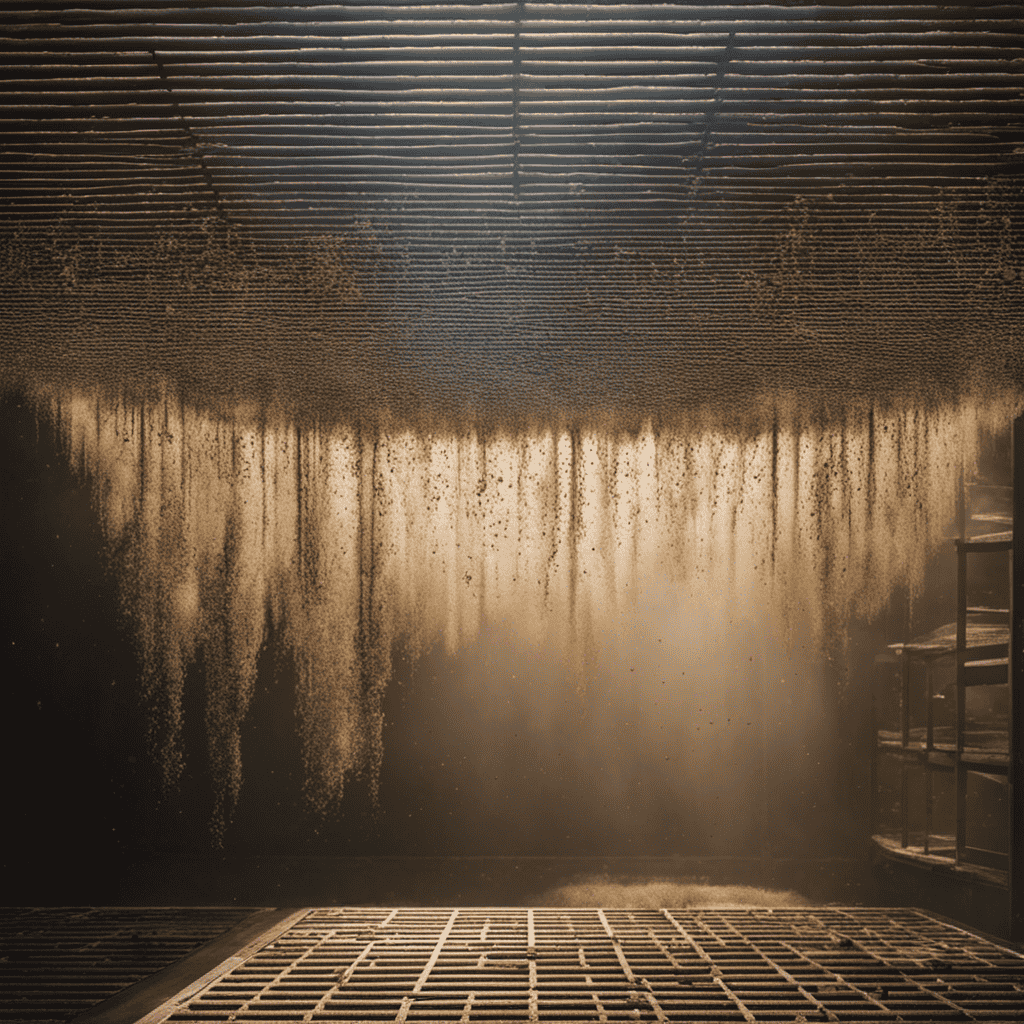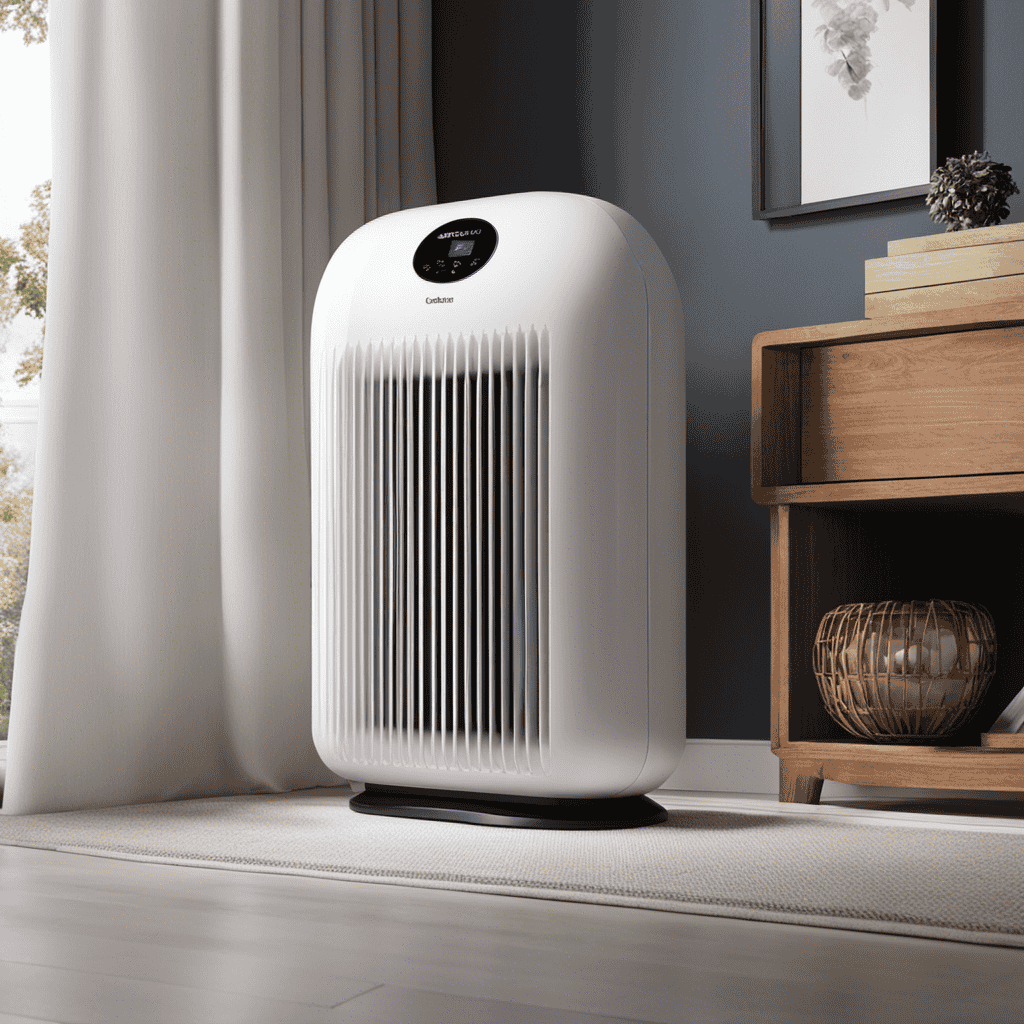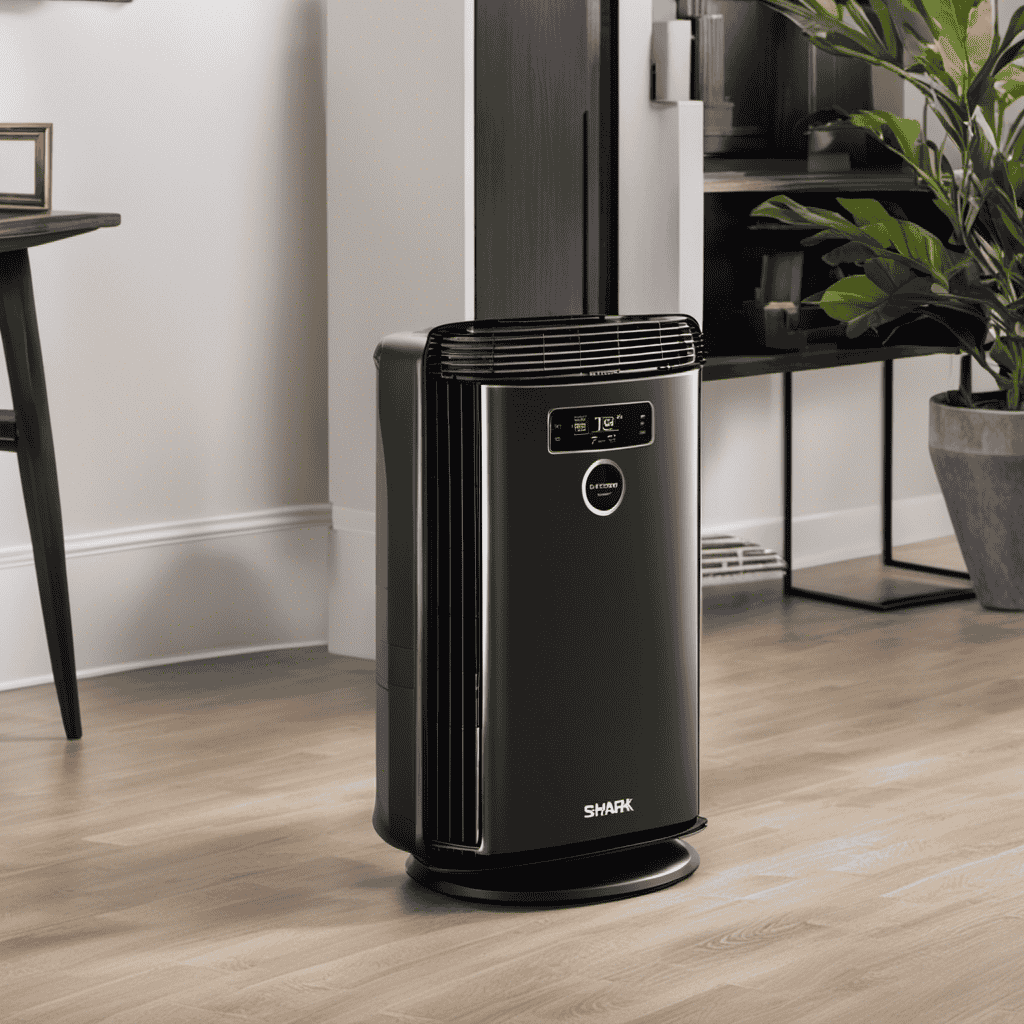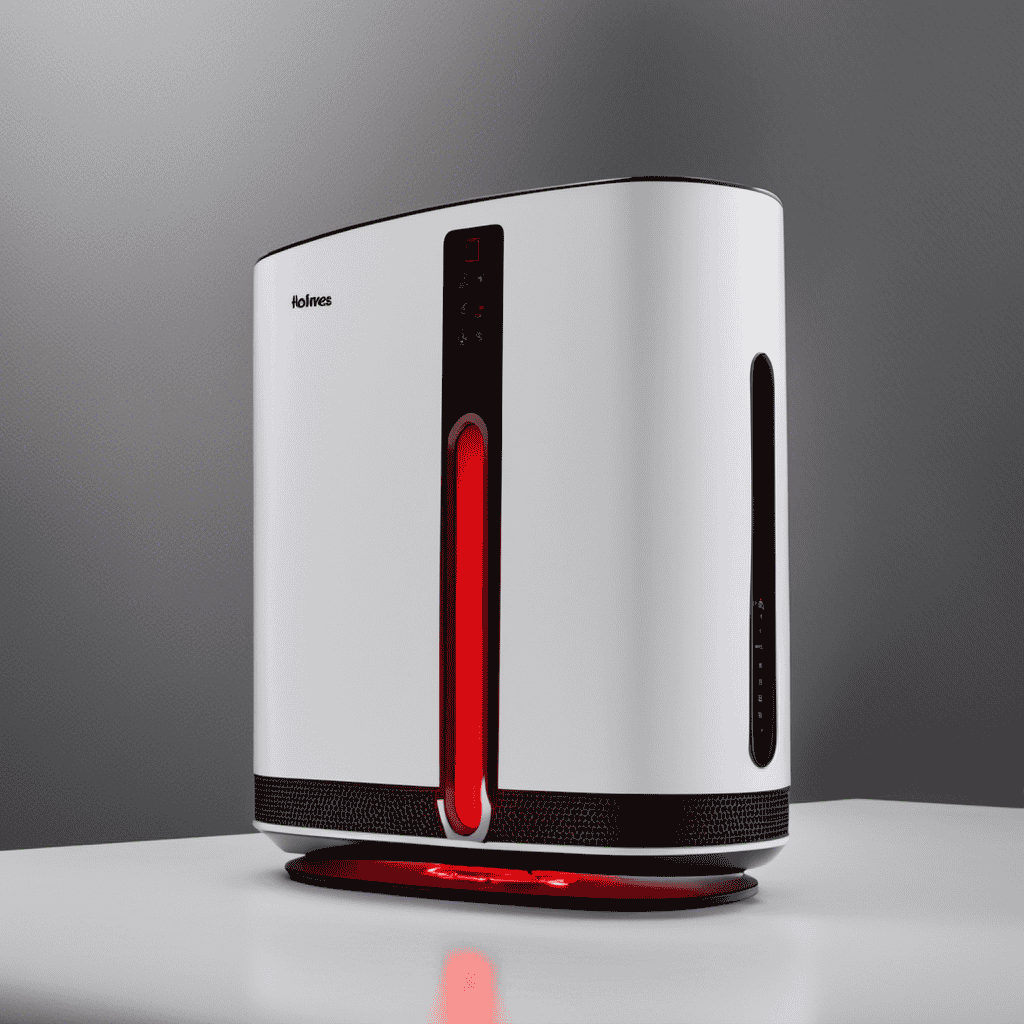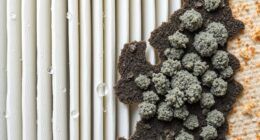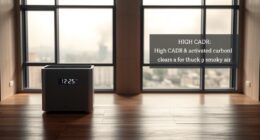Did you realize that the typical individual spends approximately 90% of their time indoors? Given the significant amount of time spent indoors, it is crucial to make sure the air we are breathing is pure and beneficial to our health.
One key component of maintaining good indoor air quality is regularly changing the air purifier filter. In this article, I will provide you with all the information you need to know about how often to change your air purifier filter, signs that it needs replacement, and tips to extend its lifespan.
Key Takeaways
- Air quality and usage patterns are important factors in determining how often an air purifier filter needs to be changed.
- Regular maintenance, including cleaning washable filters and replacing disposable filters as recommended, is crucial for prolonging the lifespan of the air purifier and ensuring its effectiveness.
- Choosing a high-quality filter with a high MERV rating and the right type for specific needs (HEPA, activated carbon, electrostatic) is essential for optimal filtration.
- When replacing filters, it is important to follow the manufacturer’s instructions, turn off the unit, install the filter correctly, and use compatible filters. Additionally, troubleshooting common filter replacement issues can help ensure proper installation.
Factors That Affect Filter Lifespan
Factors like air quality, usage time, and filter type can affect how often I need to change an air purifier filter.
Air quality plays a significant role in determining the lifespan of the filter. If I live in an area with high pollution or allergens, the filter may get clogged more quickly, requiring more frequent changes.
Usage time also matters; if I use the air purifier for longer periods or in rooms with more contaminants, the filter will accumulate more particles and need to be replaced sooner.
Additionally, the type and quality of the filter itself affect its longevity. Higher-quality filters tend to last longer but may come with a higher initial cost.
Considering these factors, I can make an informed decision about when to change my air purifier filter while balancing effectiveness and filter cost.
Recommended Filter Change Frequency
The recommended frequency for replacing an air purifier filter is typically every six months. Regularly changing your filter is essential for maintaining the efficiency of your air purifier and ensuring that it continues to provide clean and healthy air in your home.
Several factors can affect the efficiency of your filter, such as the amount of pollutants in your environment, the size of your home, and the frequency of use. By changing your filter regularly, you can improve the overall performance of your air purifier and reduce the risk of respiratory issues caused by poor air quality.
As we explore the signs that your filter needs replacement, it is important to understand the benefits of regular filter changes in maintaining the effectiveness of your air purifier.
Signs That Your Filter Needs Replacement
One of the signs that your filter needs replacement is when it starts to emit a musty or unpleasant odor. This can indicate that the filter is clogged and unable to effectively remove pollutants from the air.
There are several factors that can affect filter performance and lead to clogging. These include:
-
Dust and debris: Over time, dust and debris can accumulate on the filter, reducing its ability to capture pollutants.
-
Pet hair and dander: If you have pets, their hair and dander can quickly clog up the filter, impacting its efficiency.
-
Smoking: Smoking indoors can release harmful chemicals into the air, which can quickly clog the filter.
-
High levels of air pollution: If you live in an area with high levels of air pollution, your filter may become clogged more quickly.
Regularly checking your filter and replacing it when necessary is essential to maintain clean and healthy indoor air quality.
How to Extend the Life of Your Filter
When it comes to extending the life of your filter, there are a few key points to keep in mind.
First, proper maintenance techniques are essential. This includes regularly cleaning or replacing the filter, as well as ensuring that the air purifier is kept in a clean and dust-free environment.
Secondly, understanding the recommended filter replacement frequency is crucial in order to maintain optimal air quality.
Lastly, knowing the right cleaning methods for your specific type of filter is important to ensure its longevity and effectiveness.
Proper Maintenance Techniques
To ensure optimal performance, you should regularly clean and replace your air purifier filter. Here are some filter maintenance tips to help you enjoy the benefits of clean air:
-
Vacuum the filter: Use a soft brush attachment to gently remove dust and debris from the surface of the filter.
-
Rinse with water: Depending on the type of filter, you may be able to rinse it under running water to remove trapped particles.
-
Let it dry: After rinsing, make sure the filter is completely dry before reinstalling it to avoid mold growth.
-
Replace when necessary: Even with regular cleaning, filters eventually become less effective. Replace your filter as recommended by the manufacturer to maintain optimal air quality.
By following these filter maintenance tips, you can ensure that your air purifier continues to provide clean and fresh air.
Now, let’s discuss how frequently you should replace your air purifier filter.
Filter Replacement Frequency
Make sure you regularly check the manufacturer’s recommendations for how often to replace your air purifier filter. The frequency of filter replacement can vary depending on several factors affecting filter efficiency. These factors include the level of pollution in your area, the size of your living space, and the presence of pets or smokers in your home.
By following the manufacturer’s recommendations, you can ensure that your air purifier is functioning at its optimal level and effectively removing pollutants from your indoor air.
When it comes to cost-effective filter options, there are several choices available. Some filters are washable and reusable, allowing you to save money in the long run. Others may have a higher initial cost but offer longer lifespan and superior filtration capabilities. Ultimately, the right filter option for you will depend on your specific needs and budget.
As we consider the frequency of filter replacement, it’s also important to discuss the cleaning methods for filters.
Cleaning Methods for Filters
Using gentle soap and warm water, rinse the filter thoroughly to remove any accumulated dust and debris. Regular cleaning of air purifier filters is essential to maintain their effectiveness and prolong their lifespan. Here are four important points to consider when cleaning your air purifier filter:
-
Cleaning frequency: It’s recommended to clean your air purifier filter every 3-6 months, depending on the manufacturer’s instructions and the level of air pollution in your area.
-
Proper technique: Follow the manufacturer’s instructions for cleaning your specific filter model. Gently remove the filter and rinse it under running water, using a mild soap if necessary. Avoid using harsh chemicals or abrasive materials that could damage the filter.
-
Drying process: After cleaning, allow the filter to air dry completely before reinstalling it. Placing a wet filter back into the air purifier can lead to mold and bacteria growth.
-
Filter replacement cost: While regular cleaning is important, filters do have a limited lifespan. Eventually, they will need to be replaced. Research the cost of replacement filters for your specific air purifier model to ensure you budget accordingly.
Different Types of Air Purifier Filters
When it comes to air purifier filters, it’s important to consider their lifespan and effectiveness. Knowing how long a filter will last and how well it can remove pollutants from the air can help you make an informed decision.
Additionally, choosing the right filter for your specific needs and environment is crucial in ensuring optimal air purification results.
Filter Lifespan and Effectiveness
The filter’s lifespan and effectiveness can vary depending on factors such as air quality and usage patterns. Here are four key factors that can affect the performance of an air purifier filter:
-
Air Quality: The level of pollutants in the air directly impacts the filter’s lifespan. If the air quality is poor, with high levels of dust, pet dander, or smoke, the filter will need to work harder and may need to be replaced more frequently.
-
Usage Patterns: How often and for how long the air purifier is used also plays a role. If the purifier is running constantly or in a heavily polluted area, the filter will need to be changed more frequently.
-
Maintenance: Regular cleaning and maintenance can help prolong the lifespan of the filter. Vacuuming the pre-filter and following the manufacturer’s instructions for filter replacement or cleaning are important.
-
Filter Quality: The quality of the filter itself can determine its effectiveness and lifespan. Higher quality filters may last longer and provide better filtration.
Considering these factors, it is important to choose the right filter for your needs.
Choosing the Right Filter
To choose the right filter, consider factors such as air quality, usage patterns, maintenance, and filter quality. These factors can greatly affect the performance of your air purifier and ensure that it is effective in removing pollutants from the air. When it comes to air quality, factors such as the presence of allergens, dust, pet dander, and smoke should be taken into account. Usage patterns refer to the amount of time the air purifier will be running and the size of the room it will be placed in. Maintenance includes regular cleaning and filter replacement. Lastly, filter quality determines how efficiently the filter can capture and remove particles from the air. Choosing the right size filter is also crucial, as it should be able to effectively clean the air in the room it is placed in.
| Factors Affecting Performance | Choosing the Right Size |
|---|---|
| Air quality | Room size |
| Usage patterns | Air purifier capacity |
| Maintenance | |
| Filter quality |
The Importance of Regular Filter Maintenance
Regular filter maintenance is crucial for maintaining the effectiveness of an air purifier. Here are four essential filter maintenance tips to ensure your air purifier continues to provide clean and fresh air:
-
Regularly check the filter: Check the filter every 2-3 months to see if it needs cleaning or replacement. This will help maintain optimal filtration efficiency.
-
Clean the filter: If your air purifier has a washable filter, clean it according to the manufacturer’s instructions. Regular cleaning prevents the buildup of dirt and dust, ensuring better air quality.
-
Replace the filter: If your air purifier has a disposable filter, replace it as recommended by the manufacturer. Over time, filters become clogged and less effective at removing pollutants from the air.
-
Enjoy the benefits of clean air: By regularly maintaining your air purifier’s filter, you ensure that it continues to remove allergens, dust, and pollutants, providing you with cleaner and healthier air to breathe.
Regular filter maintenance not only prolongs the lifespan of your air purifier but also ensures that it continues to deliver the benefits of clean air for you and your family.
Common Mistakes to Avoid When Changing Filters
When changing filters, make sure you follow the manufacturer’s instructions to avoid common mistakes. It is important to understand the frequency at which your air purifier filters need to be changed. Frequent filter changes are necessary to maintain the efficiency and effectiveness of your air purifier. However, many people make mistakes when replacing their filters, which can lead to reduced performance and potential damage to the unit. To help you avoid these common filter replacement mistakes, I have compiled a table below outlining the dos and don’ts of changing filters:
| DOs | DON’Ts |
|---|---|
| Read the manufacturer’s manual | Neglect to turn off the unit |
| Remove the old filter carefully | Install the filter incorrectly |
| Clean the filter housing | Use filters that are not compatible |
| Install the new filter correctly | Forget to reset the filter replacement reminder |
| Regularly check and replace filters | Ignore signs of filter wear and tear |
How to Choose the Right Replacement Filter
Make sure you understand the specifications of your air purifier so you can select the appropriate replacement filter. Here are four factors to consider when buying replacement filters:
-
Filter Size: Check the dimensions of your current filter and make sure the replacement filter matches those measurements. Using the wrong size can result in poor filtration and reduced effectiveness.
-
Filtration Efficiency: Look for filters that have a high MERV (Minimum Efficiency Reporting Value) rating. The higher the rating, the better the filter is at capturing small particles like dust, pollen, and pet dander.
-
Filter Type: There are different types of filters available, such as HEPA (High-Efficiency Particulate Air), activated carbon, and electrostatic. Consider your specific needs and choose a filter that targets the pollutants you want to remove from the air.
-
Filter Life: Check the recommended lifespan of the replacement filter. Some filters need to be replaced every 3 to 6 months, while others can last up to a year. Regularly changing the filter ensures optimal performance and clean air.
To maintain the quality of your air purifier filters, follow these tips:
-
Regular Cleaning: Clean the exterior of the air purifier regularly to prevent dust and dirt buildup. This will help maintain airflow and prevent strain on the filter.
-
Vacuum Pre-Filter: If your air purifier has a pre-filter, vacuum it regularly to remove larger particles and extend the life of the main filter.
-
Avoid Harsh Chemicals: When cleaning the filter, avoid using harsh chemicals or detergents, as they can damage the filter material. Instead, use a gentle cleanser or simply rinse with water.
-
Monitor Filter Replacement: Keep track of when your filters need to be replaced. Set reminders or mark it on a calendar to ensure timely replacements and maintain optimal air quality.
Troubleshooting Filter Replacement Issues
If you’re experiencing difficulties with replacing the filter, double-check the dimensions to ensure it matches your air purifier. Troubleshooting filter installation problems can be frustrating, but with the right approach, you can overcome common filter replacement mistakes.
One of the most common errors is not properly aligning the filter with the air purifier. Make sure the filter is inserted correctly, following the manufacturer’s instructions.
Another mistake is forgetting to remove the protective plastic cover before installing the filter. This can restrict airflow and reduce the effectiveness of the air purifier.
Additionally, some people forget to reset the filter replacement indicator after installing a new filter. This can lead to inaccurate readings and may result in premature filter replacement.
Is There a Standard Timeframe for Changing Air Purifier Filters?
Yes, there is a standard air purifier filter replacement frequency. It is recommended to change air purifier filters every 3 to 6 months, depending on the specific model and usage. Regular filter changes ensure optimal performance and clean air quality in your home.
Frequently Asked Questions
Can I Clean and Reuse My Air Purifier Filter Instead of Replacing It?
I can clean and reuse my air purifier filter, but it may reduce its cleaning effectiveness and filter longevity. It’s recommended to replace the filter regularly to ensure optimal performance and improve indoor air quality.
How Do I Know if My Air Purifier Filter Is Still Effective Even if It Hasn’t Reached the Recommended Filter Change Frequency?
I frequently test the effectiveness of my air purifier filter to ensure it’s still working well, even if it hasn’t reached the recommended change frequency. It’s a simple way to prolong its lifespan and keep my air clean.
Are There Any Health Risks Associated With Not Changing the Air Purifier Filter Regularly?
Not changing the air purifier filter regularly can pose potential health risks. It’s important to prioritize regular filter changes to ensure the air you breathe is clean and free from pollutants.
Can I Use a Different Brand or Type of Filter as a Replacement for My Air Purifier?
Sure, you can use a different brand or type of filter as a replacement for your air purifier. However, it’s important to consider the pros and cons of using different filter types for air purifiers to ensure optimal performance.
Is It Necessary to Turn off the Air Purifier Before Replacing the Filter?
Yes, it is necessary to unplug the air purifier before changing the filter to avoid any electrical accidents. Regularly changing the air purifier filter ensures optimal performance by removing pollutants and improving air quality in your home.
Conclusion
In conclusion, taking care of your air purifier filter is crucial for maintaining clean and healthy indoor air. Just like changing the oil in your car to keep the engine running smoothly, regularly replacing your filter ensures optimal performance.
Think of your filter as the guardian of your air quality, tirelessly capturing pollutants and allergens. By adhering to the recommended filter change frequency and practicing proper maintenance, you’ll create a fortress of clean air in your home.
Remember, a little filter care goes a long way in safeguarding your health and well-being.
